This weekend marked the end of Germany’s customary winter break period and the beginning of this season’s second half, also known as the Rückrunde. Apart from being a necessity due to the harsh winters, this pause in the campaign also allows clubs to recharge the batteries and either make a push for European places or avoid the threat of relegation.
Saturday’s match between Bayer Leverkusen and Borussia Mönchengladbach featured two teams at opposite ends of this spectrum. Hosts Leverkusen came into the fixture a lamentable ninth place. They are a team with such attacking talent and potential looking very much less than a sum of their parts. To put an end to the season’s early malaise, manager Heiko Herrlich was replaced by former Dortmund and Ajax coach Peter Bosz.
On the other hand visitors Gladbach looked to respond to second place Bayern Munich’s victory on Friday and continue their expectations of Champions League qualification. This tactical analysis will look back and explain how the match unfolded.
Team selections
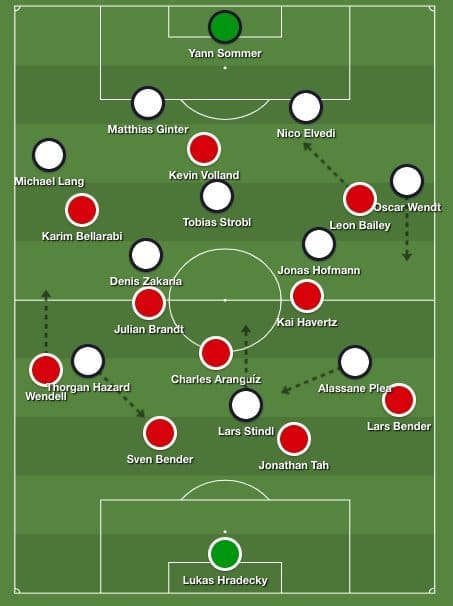
All the focus was on Peter Bosz and which team and tactical style he would try to implement in his first game in charge. The Dutchman, a long-time advocate of the attacking, fluid 4-3-3, is seen as the right man to get the very best out of Leverkusen’s considerable attacking talent. Kai Havertz, Leon Bailey, Julian Brandt, and Kevin Volland are just some of the talent at his disposal.
Bosz’s teams have always stayed true to his philosophies which very much fall in line with the legacy of Dutch managers before him. When attacking possession is regarded as sacred and paramount to success. Defensively, his teams counter-press to win the ball back quickly. Combine this with the ability to counter-attack at speed, and Leverkusen have the potential to become a devastating force. Bosz picked a team which reflected this, with his midfield trio of Aranguiz, Havertz and Brandt staggeringly front-footed.
As for Gladbach, Dieter Hecking had a much more straight-forward task in picking his ideal XI. Having not yet made any transfers since the start of January’s window, Die Fohlen went their own version of a 4-3-3. The front three of Thorgan Hazard, Alassane Pléa, and Lars Stindl was undoubtedly the key area of the pitch. They were also boosted by the returns of Matthias Ginter and Jonas Hoffmann following injury layoffs.
First half
As expected, Leverkusen began the match pressing extremely high up the pitch. Their front three pressed extremely high up on Gladbach whenever they conducted their build-up. Leverkusen also dominated the match in terms of possession for the first 30 minutes (eventually finishing with 64% of the ball) and did not allow Gladbach to create many opportunities going forward.
To combat this threat, Gladbach sat into a 4-5-1 shape which only applied considerable pressure when Bayer reached the halfway line. Aiming to stay compact and stop the space in behind for Bailey and Bellarabi to drive into was clearly a part of Dieter Hecking’s match plan.

When Gladbach did apply brief periods of pressure to force Leverkusen to go long, goalkeeper Lukas Hradecky aimed to bypass this by playing over the first line and find wingers or fullbacks. His opposite number Yann Sommer did the same.
Compared to Leverkusen’s comparatively slower and more considered build-up – when they weren’t on the counter, that is – Gladbach’s attack was direct and early. It was another way they attempted to get around the heavy press they encountered. For the majority of the half, this approach led to the ball being lost and Gladbach retreating into shape.
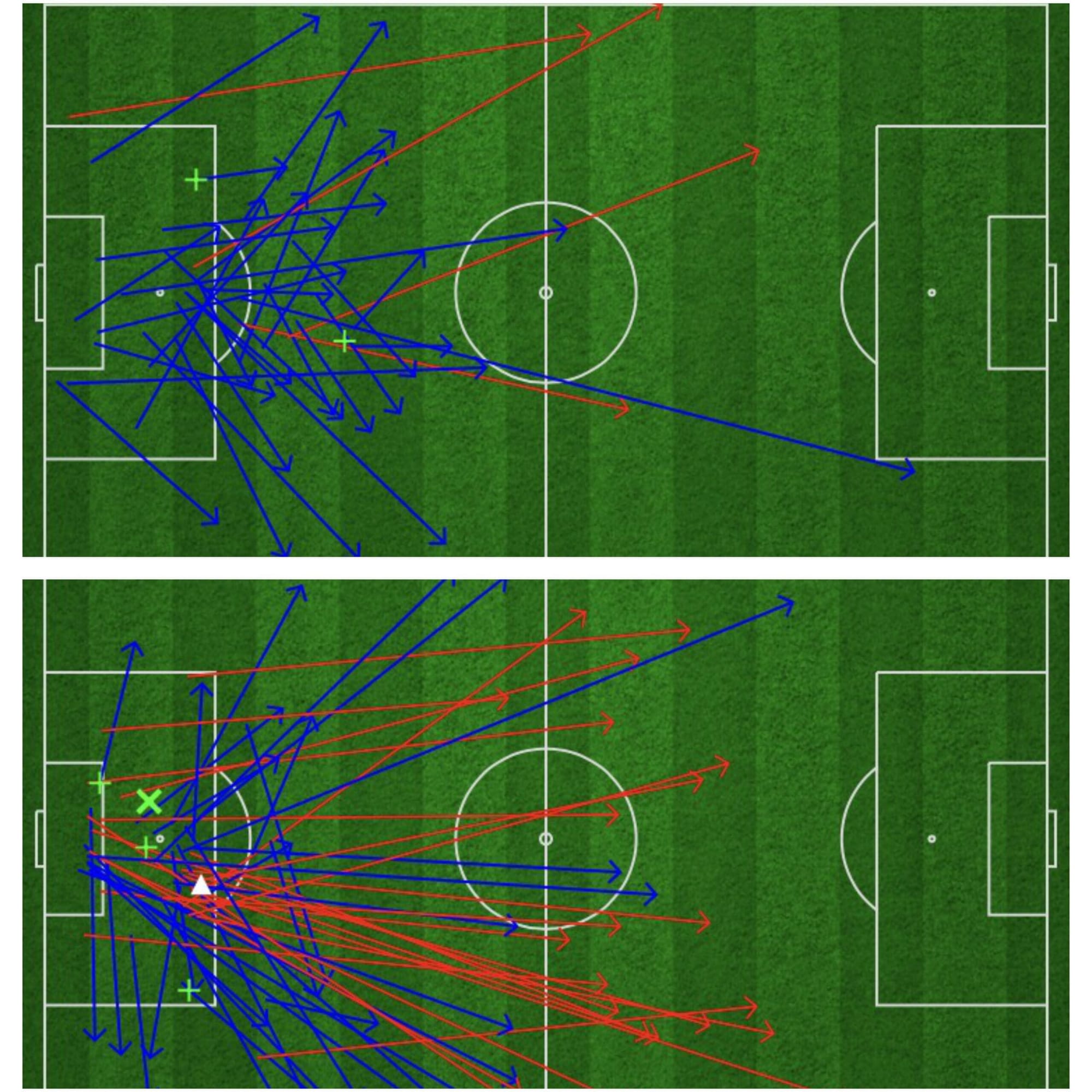
This pattern of play all changed in the 36th minute when Gladbach finally had their first period of sustained possession. As opposed to Alassane Plea who is a forward much more inclined to run in behind, Lars Stindl very much thrives coming deep to combine and essentially play as a number 10. Defenders are forced to either commit or leave him free to create.
In this specific moment of the match shown below, Stindl is allowed to turn and slip in Plea who finishes confidently from inside the penalty area across the goal. Despite not creating much, Gladbach had the lead going into the break.
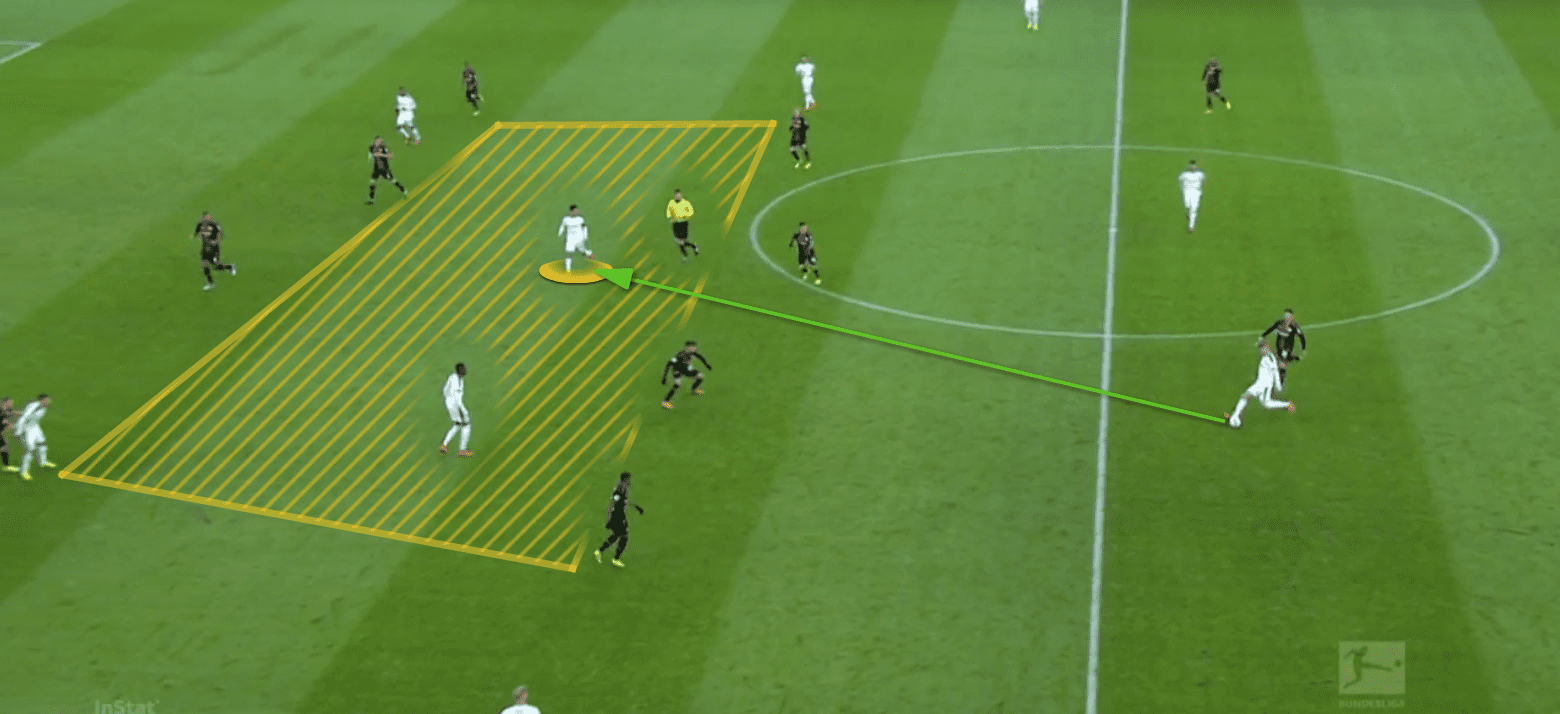
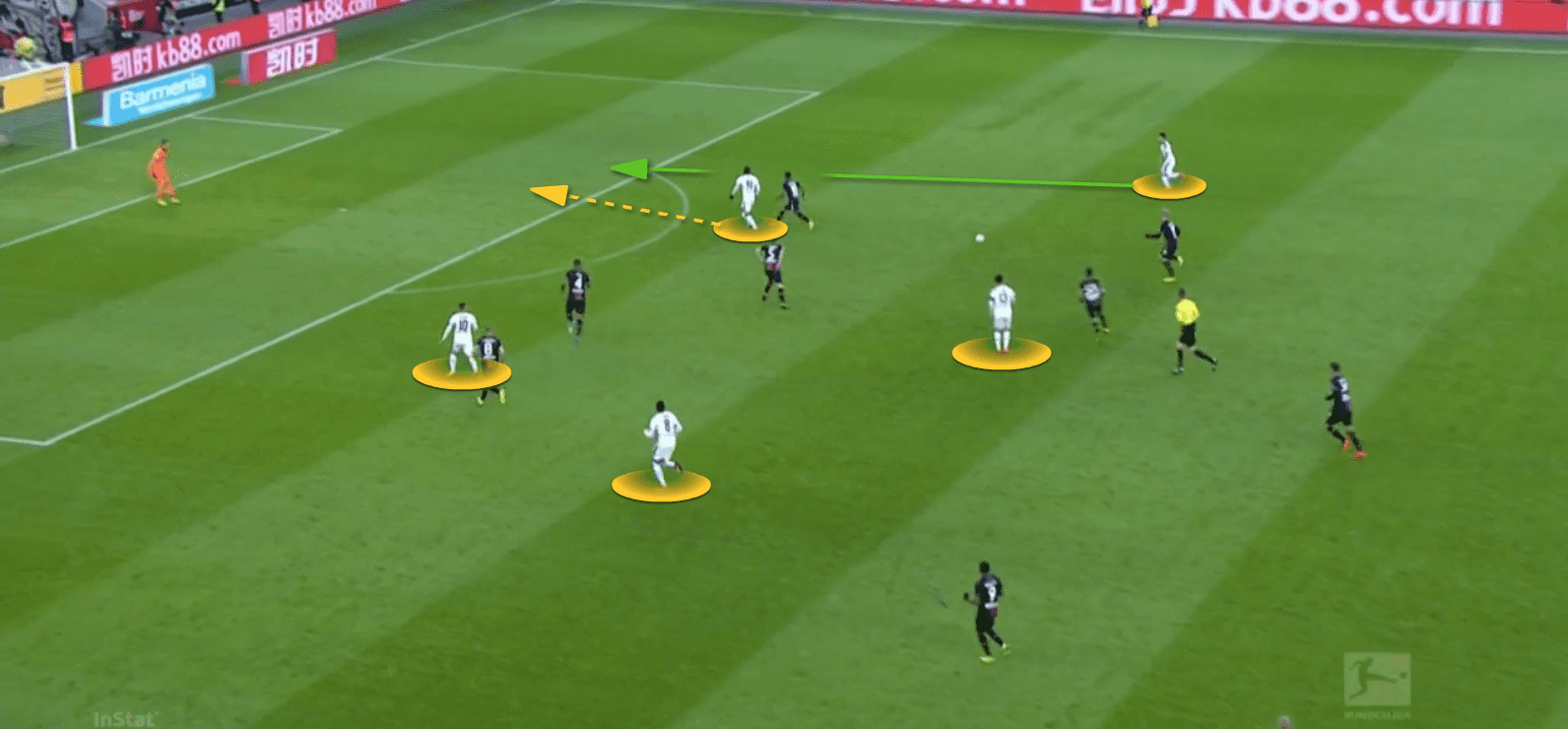
Second half
The second half very much followed a similar path as the first, but cranked up to a higher degree of Leverkusen superiority. Clearly fired up by going a goal behind, Leon Bailey, Bellarabi, et al constantly threatened to equalise with crosses, cutbacks and shots in the Gladbach penalty area.
Combined with these wide threats, Kai Havertz and Julian Brandt increasingly broke ahead of the ball to try and overload the opposition. Up to this point, the latter had been more involved in the build-up than in the final third. The pitch was very clogged centrally as a result, which created space for the wide players to exploit and try to win one-on-one duels, but nothing came from these scenarios.

On the other side, Leverkusen’s domination over the second half was aided by Gladbach’s inability to find an out ball. Stindl up front is not the type of centre-forward to win physical tussles with defenders such as Jonathan Tah or Sven Bender. As a result of this, Thorgan Hazard was often the player tasked with dribbling out of pressure or flicking the ball on to teammates who were largely half-way across the pitch.
Sensing these issues, Dieter Hecking brought on midfielders and Christoph Kramer in like-for-like changes to provide more stability. It seemed like only a matter of time before Leverkusen would score. Unfortunately for Peter Bosz, wastefulness spoiled his debut at the BayArena, and Gladbach walked away with all three points.
Observations
Leverkusen look without a doubt a better side after the winter break, despite the defeat. The pressing and continued attacking style of Bosz perfectly matches the balance of his youthful and exciting team. However, the lack of a clinical and sharp edge once they find themselves in advanced positions in worrying.
In the Bundesliga their top goalscorer, Havertz, only has six goals. For a club aiming to shoot up the table, this lack of a clinical finisher is not sustainable. Looking at the underlying numbers Bayer Leverkusen are 10th in expected goals not including penalties with 25.04. For a club with such a glut of wide threats, and threats from midfield, the lack of a true number nine is problematic.
On the same token, Leon Bailey and Karim Bellarabi’s wastefulness in advanced positions handicapped their team. Much of the onus to create chances for Bayer was placed at the feet of these two and they failed to deliver time after time. Crosses failed to find their expected targets and Gladbach remained comfortable within the width of their area. Also, when Leverkusen was able to counter with speed, the final ball or shot went begging.

For Dieter Hecking and Gladbach, despite being conservative and on the back foot for much of the match, their relative comfort in dealing with danger will be hugely pleasing to them. While the team do possess a number of attacking players capable of creating danger, their ability to keep opponents at arm’s length has been key in their performances.
In situations where they have gone a goal ahead, they’ve only conceded three. Whether this sturdiness can last till the end of the season remains to be seen, but Gladbach fans should be very positive going forward.
Summary
While Leverkusen will be disappointed that Peter Bosz’s first game in charge ended in defeat, the positivity surrounding his appointment should not be dampened. Selecting a typically positive team in his favoured 4-3-3 should, on the basis of this match, unlock the attacking talents Die Werkself possess.
For Gladbach, it was a case of picking up where they left off in matches previously. Hecking has made his team very hard to beat due to their organised, disciplined approach. With the attacking talents of Plea, Stindl, Hazard et al, they can take on their opponents comfortably.
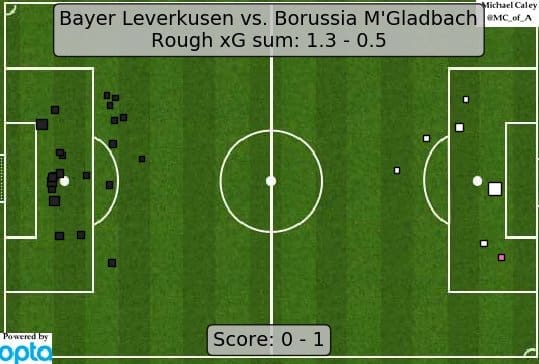
If you love tactical analysis, then you’ll love the digital magazines from totalfootballanalysis.com – a guaranteed 100+ pages of pure tactical analysis covering topics from the Premier League, Serie A, La Liga, Bundesliga and many, many more. Buy your copy of the January issue for just ₤4.99 here, or even better sign up for a ₤50 annual membership (12 monthly issues plus the annual review) right here.

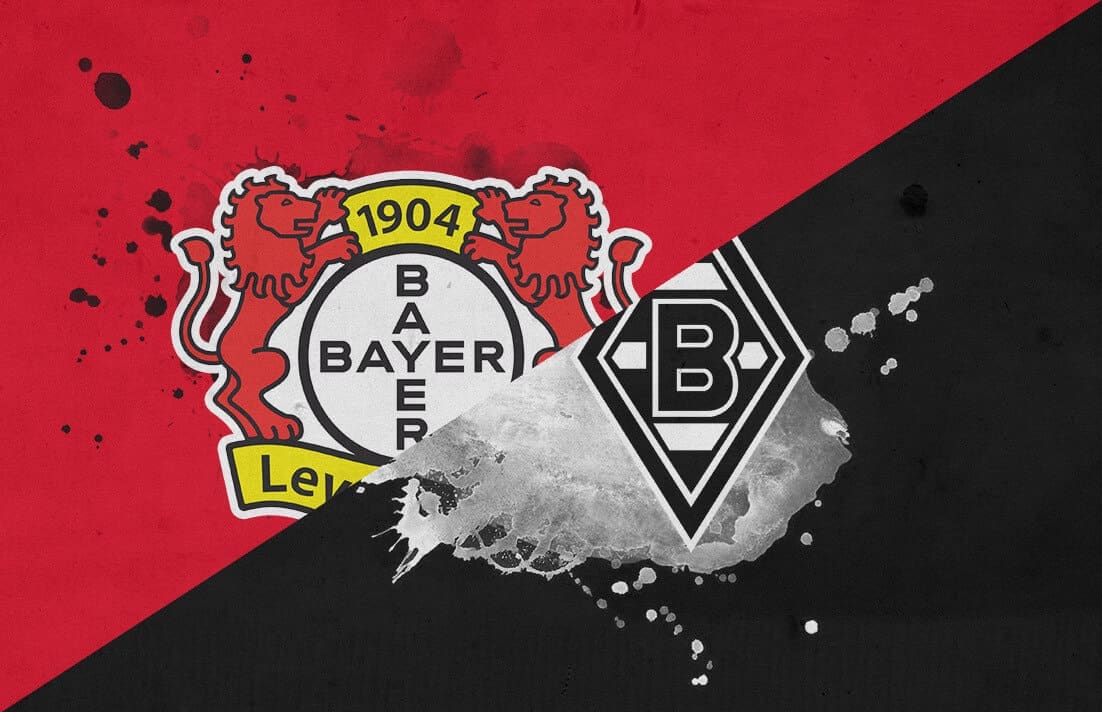



Comments